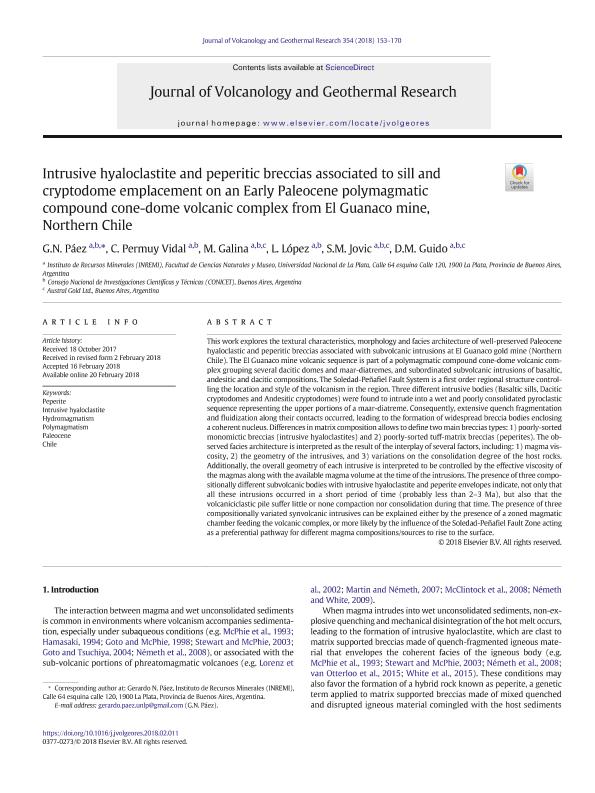Mostrar el registro sencillo del ítem
dc.contributor.author
Paez, Gerardo Nestor

dc.contributor.author
Permuy Vidal, Conrado

dc.contributor.author
Galina, Matias

dc.contributor.author
López, Luciano

dc.contributor.author
Jovic, Sebastian Miguel

dc.contributor.author
Guido, Diego Martin

dc.date.available
2020-03-16T21:04:31Z
dc.date.issued
2018-04
dc.identifier.citation
Paez, Gerardo Nestor; Permuy Vidal, Conrado; Galina, Matias; López, Luciano; Jovic, Sebastian Miguel; et al.; Intrusive hyaloclastite and peperitic breccias associated to sill and cryptodome emplacement on an Early Paleocene polymagmatic compound cone-dome volcanic complex from El Guanaco mine, Northern Chile; Elsevier Science; Journal of Volcanology and Geothermal Research; 354; 4-2018; 153-170
dc.identifier.issn
0377-0273
dc.identifier.uri
http://hdl.handle.net/11336/99711
dc.description.abstract
This work explores the textural characteristics, morphology and facies architecture of well-preserved Paleocene hyaloclastic and peperitic breccias associated with subvolcanic intrusions at El Guanaco gold mine (Northern Chile). The El Guanaco mine volcanic sequence is part of a polymagmatic compound cone-dome volcanic complex grouping several dacitic domes and maar-diatremes, and subordinated subvolcanic intrusions of basaltic, andesitic and dacitic compositions. The Soledad-Peñafiel Fault System is a first order regional structure controlling the location and style of the volcanism in the region. Three different intrusive bodies (Basaltic sills, Dacitic cryptodomes and Andesitic cryptodomes) were found to intrude into a wet and poorly consolidated pyroclastic sequence representing the upper portions of a maar-diatreme. Consequently, extensive quench fragmentation and fluidization along their contacts occurred, leading to the formation of widespread breccia bodies enclosing a coherent nucleus. Differences in matrix composition allows to define two main breccias types: 1) poorly-sorted monomictic breccias (intrusive hyaloclastites) and 2) poorly-sorted tuff-matrix breccias (peperites). The observed facies architecture is interpreted as the result of the interplay of several factors, including: 1) magma viscosity, 2) the geometry of the intrusives, and 3) variations on the consolidation degree of the host rocks. Additionally, the overall geometry of each intrusive is interpreted to be controlled by the effective viscosity of the magmas along with the available magma volume at the time of the intrusions. The presence of three compositionally different subvolcanic bodies with intrusive hyaloclastite and peperite envelopes indicate, not only that all these intrusions occurred in a short period of time (probably less than 2–3 Ma), but also that the volcaniciclastic pile suffer little or none compaction nor consolidation during that time. The presence of three compositionally variated synvolcanic intrusives can be explained either by the presence of a zoned magmatic chamber feeding the volcanic complex, or more likely by the influence of the Soledad-Peñafiel Fault Zone acting as a preferential pathway for different magma compositions/sources to rise to the surface.
dc.format
application/pdf
dc.language.iso
eng
dc.publisher
Elsevier Science

dc.rights
info:eu-repo/semantics/openAccess
dc.rights.uri
https://creativecommons.org/licenses/by-nc-sa/2.5/ar/
dc.subject
CHILE
dc.subject
HYDROMAGMATISM
dc.subject
INTRUSIVE HYALOCLASTITE
dc.subject
PALEOCENE
dc.subject
PEPERITE
dc.subject
POLYMAGMATISM
dc.subject.classification
Vulcanología

dc.subject.classification
Ciencias de la Tierra y relacionadas con el Medio Ambiente

dc.subject.classification
CIENCIAS NATURALES Y EXACTAS

dc.title
Intrusive hyaloclastite and peperitic breccias associated to sill and cryptodome emplacement on an Early Paleocene polymagmatic compound cone-dome volcanic complex from El Guanaco mine, Northern Chile
dc.type
info:eu-repo/semantics/article
dc.type
info:ar-repo/semantics/artículo
dc.type
info:eu-repo/semantics/publishedVersion
dc.date.updated
2020-02-26T14:58:19Z
dc.journal.volume
354
dc.journal.pagination
153-170
dc.journal.pais
Países Bajos

dc.journal.ciudad
Amsterdam
dc.description.fil
Fil: Paez, Gerardo Nestor. Universidad Nacional de La Plata. Facultad de Ciencias Naturales y Museo. Instituto de Recursos Minerales. Provincia de Buenos Aires. Gobernación. Comisión de Investigaciones Científicas. Instituto de Recursos Minerales; Argentina. Consejo Nacional de Investigaciones Científicas y Técnicas; Argentina
dc.description.fil
Fil: Permuy Vidal, Conrado. Universidad Nacional de La Plata. Facultad de Ciencias Naturales y Museo. Instituto de Recursos Minerales. Provincia de Buenos Aires. Gobernación. Comisión de Investigaciones Científicas. Instituto de Recursos Minerales; Argentina. Consejo Nacional de Investigaciones Científicas y Técnicas; Argentina
dc.description.fil
Fil: Galina, Matias. Consejo Nacional de Investigaciones Científicas y Técnicas; Argentina. Universidad Nacional de La Plata. Facultad de Ciencias Naturales y Museo. Instituto de Recursos Minerales. Provincia de Buenos Aires. Gobernación. Comisión de Investigaciones Científicas. Instituto de Recursos Minerales; Argentina
dc.description.fil
Fil: López, Luciano. Universidad Nacional de La Plata. Facultad de Ciencias Naturales y Museo. Instituto de Recursos Minerales. Provincia de Buenos Aires. Gobernación. Comisión de Investigaciones Científicas. Instituto de Recursos Minerales; Argentina. Consejo Nacional de Investigaciones Científicas y Técnicas; Argentina
dc.description.fil
Fil: Jovic, Sebastian Miguel. Consejo Nacional de Investigaciones Científicas y Técnicas; Argentina. Universidad Nacional de La Plata. Facultad de Ciencias Naturales y Museo. Instituto de Recursos Minerales. Provincia de Buenos Aires. Gobernación. Comisión de Investigaciones Científicas. Instituto de Recursos Minerales; Argentina
dc.description.fil
Fil: Guido, Diego Martin. Consejo Nacional de Investigaciones Científicas y Técnicas; Argentina. Universidad Nacional de La Plata. Facultad de Ciencias Naturales y Museo. Instituto de Recursos Minerales. Provincia de Buenos Aires. Gobernación. Comisión de Investigaciones Científicas. Instituto de Recursos Minerales; Argentina
dc.journal.title
Journal of Volcanology and Geothermal Research

dc.relation.alternativeid
info:eu-repo/semantics/altIdentifier/url/https://www.sciencedirect.com/science/article/pii/S0377027317306029
dc.relation.alternativeid
info:eu-repo/semantics/altIdentifier/doi/http://dx.doi.org/10.1016/j.jvolgeores.2018.02.011
Archivos asociados
